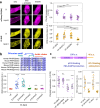Non-catalytic role of phosphoinositide 3-kinase in mesenchymal cell migration through non-canonical induction of p85β/AP2-mediated endocytosis
- PMID: 38521786
- PMCID: PMC10960865
- DOI: 10.1038/s41467-024-46855-y
Non-catalytic role of phosphoinositide 3-kinase in mesenchymal cell migration through non-canonical induction of p85β/AP2-mediated endocytosis
Abstract
Class IA phosphoinositide 3-kinase (PI3K) galvanizes fundamental cellular processes such as migration, proliferation, and differentiation. To enable these multifaceted roles, the catalytic subunit p110 utilizes the multi-domain, regulatory subunit p85 through its inter SH2 domain (iSH2). In cell migration, its product PI(3,4,5)P3 generates locomotive activity. While non-catalytic roles are also implicated, underlying mechanisms and their relationship to PI(3,4,5)P3 signaling remain elusive. Here, we report that a disordered region of iSH2 contains AP2 binding motifs which can trigger clathrin and dynamin-mediated endocytosis independent of PI3K catalytic activity. The AP2 binding motif mutants of p85 aberrantly accumulate at focal adhesions and increase both velocity and persistency in fibroblast migration. We thus propose the dual functionality of PI3K in the control of cell motility, catalytic and non-catalytic, arising distinctly from juxtaposed regions within iSH2.
© 2024. The Author(s).
Conflict of interest statement
The authors declare no competing interests.
Figures




Update of
-
Non-catalytic role of phosphoinositide 3-kinase in mesenchymal cell migration through non-canonical induction of p85β/AP-2-mediated endocytosis.Res Sq [Preprint]. 2023 Jan 20:rs.3.rs-2432041. doi: 10.21203/rs.3.rs-2432041/v1. Res Sq. 2023. Update in: Nat Commun. 2024 Mar 23;15(1):2612. doi: 10.1038/s41467-024-46855-y. PMID: 36712095 Free PMC article. Updated. Preprint.
-
Non-catalytic role of phosphoinositide 3-kinase in mesenchymal cell migration through non-canonical induction of p85β/AP-2-mediated endocytosis.bioRxiv [Preprint]. 2023 Jan 2:2022.12.31.522383. doi: 10.1101/2022.12.31.522383. bioRxiv. 2023. Update in: Nat Commun. 2024 Mar 23;15(1):2612. doi: 10.1038/s41467-024-46855-y. PMID: 36712134 Free PMC article. Updated. Preprint.
References
MeSH terms
Substances
Grants and funding
LinkOut - more resources
Full Text Sources
Research Materials
Miscellaneous

